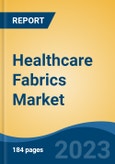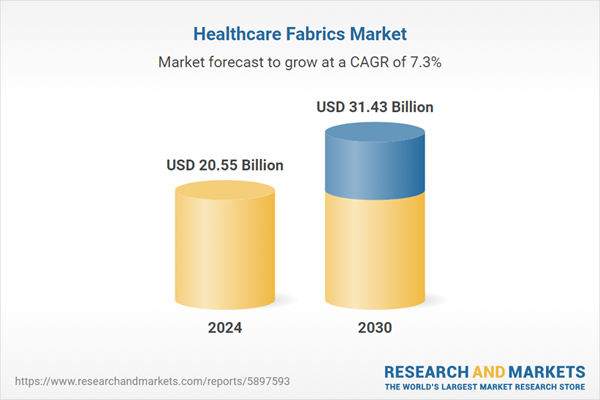Speak directly to the analyst to clarify any post sales queries you may have.
10% Free customizationThis report comes with 10% free customization, enabling you to add data that meets your specific business needs.
This growth trajectory is further supported by rising patient volumes, a sharp focus on infection prevention protocols, and a shift toward value-based healthcare that prioritizes both patient outcomes and operational efficiency. Sustained investments in medical textile innovation such as biodegradable nonwovens and smart fabrics with sensor integration are redefining product performance benchmarks. Consequently, the Global Healthcare Fabrics market is strategically positioned for long-term value creation, with market players leveraging technological advancements to meet the evolving demands of next-generation healthcare infrastructure.
Key Market Drivers
Growth in Demand for Personal Protective Equipment (PPE)
The rising global demand for Personal Protective Equipment (PPE) has emerged as a pivotal growth driver for the Global Healthcare Fabrics market. As the healthcare sector faces increasing pressure to maintain high safety standards particularly in light of recent global health crises such as the COVID-19 pandemic the reliance on high-quality healthcare fabrics for manufacturing PPE has intensified significantly. A significantly higher proportion of healthcare personnel utilized comprehensive protective gear, with 47.6% wearing masks combined with caps, 36.8% with goggles, and 25.4% with face shields.In contrast, such usage was nearly nonexistent among individuals working outside of hospital settings a statistically significant difference (P < 0.001), aligning with expectations due to differing exposure risks. PPE items such as surgical masks, gowns, coveralls, caps, and shoe covers rely heavily on nonwoven and antimicrobial healthcare fabrics that offer properties such as fluid resistance, breathability, and bacterial filtration. These fabrics are engineered to meet strict regulatory standards while ensuring both protection for medical professionals and comfort during prolonged usage. The rising awareness of healthcare-associated infections (HAIs), coupled with the growing adoption of infection control protocols, has made PPE a non-negotiable requirement in both clinical and non-clinical healthcare environments.
Expanding government mandates and international safety guidelines have compelled healthcare facilities, manufacturing units, and public institutions to increase their stockpiles of PPE, thereby creating sustained demand for medical-grade fabrics. The situation is further amplified by increased healthcare spending, particularly in emerging economies where infrastructure upgrades include significant investments in protective equipment. Global PPE manufacturers are shifting toward sustainable and technologically advanced fabric solutions such as biodegradable nonwovens, multilayer composite textiles, and anti-viral coatings which continues to spur innovation within the healthcare fabrics space. This trend is encouraging fabric producers to scale up capacity, invest in R&D, and diversify product offerings to cater to evolving PPE requirements across hospitals, diagnostic centers, ambulatory services, and emergency response units.
The growth in PPE demand is not only expanding the consumption base for healthcare fabrics but also accelerating industry innovation, compliance upgrades, and global supply chain integration collectively positioning the healthcare fabrics market for strong and sustained growth in the foreseeable future.
Key Market Challenges
Rise in Stringent Regulatory Compliance
Compliance with strict regulations often necessitates changes in manufacturing processes and materials, which can lead to increased production costs. These additional costs can strain manufacturers' profit margins and may be passed onto consumers in the form of higher prices. For example, implementing new equipment or modifying existing production lines to meet regulatory requirements can require significant financial investments.Compliance also requires rigorous testing and certification processes, which can slow down the time-to-market for new products. This can hinder the ability of manufacturers to respond quickly to market trends and consumer demands. Moreover, the testing and certification processes may involve multiple stages and require coordination with external testing agencies, adding further complexity and time to the product development cycle.
While regulations aim to ensure safety and efficacy, they can also stifle innovation. The need to comply with stringent standards can limit the exploration of new materials and technologies that could potentially offer improved performance or cost-efficiency. This restriction on innovation may prevent manufacturers from fully leveraging the latest advancements and staying ahead of their competitors.
The high cost of regulatory compliance can create barriers to entry for new players, limiting competition in the healthcare fabrics market. New companies entering the market may face substantial expenses related to compliance, such as conducting extensive testing or implementing specialized manufacturing processes. These costs can deter potential entrants, consolidating the market power of existing players and reducing overall competitiveness. By considering these factors, it becomes evident that regulatory compliance in the healthcare fabrics market is a complex and multifaceted challenge that impacts various aspects of manufacturing, innovation, and competition.
Key Market Trends
Increased Demand for Antimicrobial Fabrics
Antimicrobial fabrics are textiles that have been specially treated or woven from fibers infused with antimicrobial agents. These agents work by inhibiting the growth of bacteria, fungi, and other microorganisms, thereby reducing the risk of infections, and promoting better hygiene practices.The demand for antimicrobial fabrics has been steadily increasing across various sectors such as healthcare, apparel, and home textiles. In the healthcare sector, hospitals and clinics play a significant role in driving this demand due to the growing emphasis on preventing healthcare-associated infections and maintaining a safer environment for patients and healthcare workers alike.
This rise in demand can be attributed to the growing awareness of illnesses that are linked to hospital environments, along with the implementation of improved healthcare practices. As more emphasis is placed on infection control, the need for antimicrobial textiles continues to grow.
One of the additional advantages of antimicrobial-treated textiles is their increased durability compared to untreated fabrics. This longevity leads to sustainable textile use in the healthcare industry, contributing to environmental responsibility.
The application of antimicrobial textiles in medical textiles, such as patient gowns, bed linens, and surgical drapes, has emerged as a significant factor driving the overall growth of the antimicrobial medical textiles market. These specialized textiles provide an added layer of protection and contribute to the overall safety and well-being of patients and healthcare professionals.
The rising demand for antimicrobial fabrics represents a significant trend in the global healthcare fabrics market. As awareness of hospital-related illnesses continues to grow and the focus on sustainability gains momentum, the demand for antimicrobial textiles is expected to further increase. This presents an opportunity for manufacturers to innovate and diversify their product offerings, thereby driving the continued growth of the healthcare fabrics market while addressing the evolving needs of the industry.
Key Market Players
- Kimberly-Clark Corporation
- Berry Global Group Inc.
- Freudenberg & Co KG
- Ahlstrom Munksjo OYJ
- Asahi Kasei Corporation
- Knoll Inc.
- Eximus Corporation
- Paramount Molded Products Inc
- Avgol Ltd.
- Carnegie Fabrics LLC
Report Scope:
In this report, the Global Healthcare Fabrics Market has been segmented into the following categories, in addition to the industry trends which have also been detailed below:Healthcare Fabrics Market, By Raw Material:
- Polypropylene
- Viscose
- Cotton
- Polyester
- Others
Healthcare Fabrics Market, By Fabric Type:
- Woven Fabrics
- Non-Woven Fabrics
- Knitted Fabrics
Healthcare Fabrics Market, By Application:
- Dressing Products
- Hygiene Products
- Blanket & Bedding
- Upholstery
- Privacy Curtains
- Others
Healthcare Fabrics Market, By Region:
- North America
- United States
- Canada
- Mexico
- Europe
- France
- United Kingdom
- Italy
- Germany
- Spain
- Asia-Pacific
- China
- India
- Japan
- Australia
- South Korea
- South America
- Brazil
- Argentina
- Colombia
- Middle East & Africa
- South Africa
- Saudi Arabia
- UAE
Competitive Landscape
Company Profiles: Detailed analysis of the major companies present in the Global Healthcare Fabrics Market.Available Customizations:
With the given market data, the publisher offers customizations according to a company's specific needs. The following customization options are available for the report.Company Information
- Detailed analysis and profiling of additional market players (up to five).
Table of Contents
Companies Mentioned
- Kimberly-Clark Corporation
- Berry Global Group Inc.
- Freudenberg & Co KG
- Ahlstrom Munksjo OYJ
- Asahi Kasei Corporation
- Knoll Inc.
- Eximus Corporation
- Paramount Molded Products Inc
- Avgol Ltd.
- Carnegie Fabrics LLC
Table Information
| Report Attribute | Details |
|---|---|
| No. of Pages | 180 |
| Published | August 2025 |
| Forecast Period | 2024 - 2030 |
| Estimated Market Value ( USD | $ 20.55 Billion |
| Forecasted Market Value ( USD | $ 31.43 Billion |
| Compound Annual Growth Rate | 7.3% |
| Regions Covered | Global |
| No. of Companies Mentioned | 10 |









